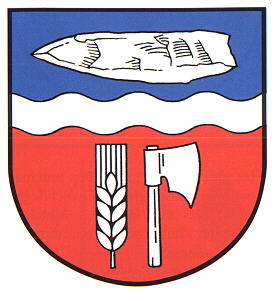Bühnsdorf: Difference between revisions
Jump to navigation
Jump to search
Knorrepoes (talk | contribs) No edit summary |
Knorrepoes (talk | contribs) No edit summary |
||
| Line 14: | Line 14: | ||
'''Origin/meaning :'''<br/> | '''Origin/meaning :'''<br/> | ||
The arms were officially granted on | The arms were officially granted on June 3, 1993. | ||
The | The chief shows a flint axe, which was found in the municipality. It refers to the long inhabitation of the area. | ||
The | The shield is divided into two parts, resembling the historical situation in which the village was divided since 1353 between the Reinfeld monastery and the local lords.<br> | ||
The wheatear and the axe refer to the agricultural character of the municipality as well as the local woodwork tradition. | |||
The | The wavy bar represents the Beek river. | ||
[[Literature]] : http://www.schleswig-holstein.de/LA/DE/06Wappenlandschaft/0604Wappenrolle/0604Wappenrolle_node.html | [[Literature]] : http://www.schleswig-holstein.de/LA/DE/06Wappenlandschaft/0604Wappenrolle/0604Wappenrolle_node.html | ||
| Line 27: | Line 28: | ||
[[Category:Schleswig-Holstein]] | [[Category:Schleswig-Holstein]] | ||
[[Category:Segeberg]] | [[Category:Segeberg]] | ||
[[Category:Granted | [[Category:Granted 1993]] | ||
Revision as of 13:10, 21 August 2011
| Heraldry of the World Civic heraldry of Germany - Deutsche Wappen (Gemeindewappen/Kreiswappen) |
BÜHNSDORF
State : Schleswig-Holstein
District (Kreis) : Segeberg
Amt : Amt Trave-Land (until 2006 Amt Segeberg-Land)
Origin/meaning :
The arms were officially granted on June 3, 1993.
The chief shows a flint axe, which was found in the municipality. It refers to the long inhabitation of the area.
The shield is divided into two parts, resembling the historical situation in which the village was divided since 1353 between the Reinfeld monastery and the local lords.
The wheatear and the axe refer to the agricultural character of the municipality as well as the local woodwork tradition.
The wavy bar represents the Beek river.
Literature : http://www.schleswig-holstein.de/LA/DE/06Wappenlandschaft/0604Wappenrolle/0604Wappenrolle_node.html

